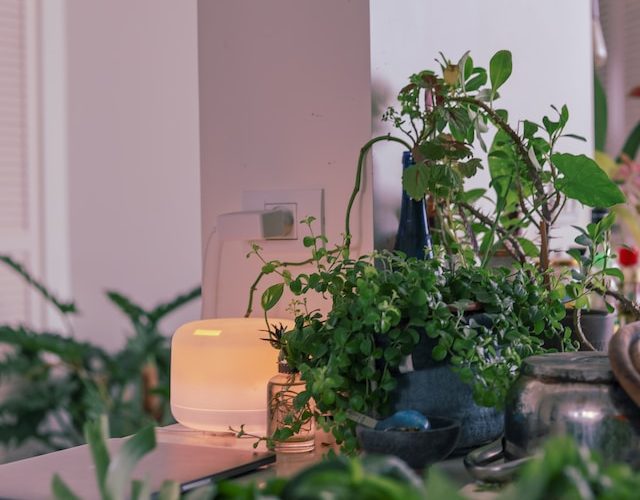Do you struggle with allergies or difficulty sleeping at night? The solution may be simpler than you think – just add some air-purifying plants to your bedroom! Not only do these green companions look beautiful and add life to your space, but they also filter out toxins in the air and boost oxygen levels. In this blog post, we’ll introduce you to five of the best air-purifying plants for improving your indoor air quality and promoting better sleep. Plus, we’ll share some tips on how to keep them alive so that you can enjoy their benefits for years to come. Let’s get started!
Aloe Vera
Aloe vera is a popular plant that’s known for its medicinal properties and ability to soothe sunburnt skin. But did you know that it also has air-purifying benefits? Aloe vera plants are effective at removing benzene and formaldehyde from the air, which can be found in household cleaning products and synthetic materials.
Not only is aloe vera an excellent addition to your bedroom for cleaner air, but it’s also low maintenance and easy to care for. They thrive in bright, indirect sunlight and prefer well-draining soil. Make sure not to overwater them as they’re drought-tolerant plants.
Another benefit of having an aloe vera plant in your room is that it releases oxygen at night, making it easier for you to breathe while sleeping. This makes it an ideal plant choice if you suffer from allergies or have trouble breathing during sleep.
The aloe vera plant offers both aesthetic appeal with its unique shape and coloration while providing practical health benefits through purifying the air we breathe.
Bamboo Palm
Bamboo Palm, also known as Chamaedorea seifrizii, is a beautiful and easy-to-care-for plant that can help purify the air in your home. This palm species is native to Mexico and Central America but has become popular worldwide for its ability to clean indoor air pollutants.
One of the benefits of Bamboo Palm is that it can filter out formaldehyde from the air. Formaldehyde is commonly found in household items such as furniture, carpeting, and cleaning products, and exposure to this chemical can cause respiratory problems over time.
In addition to its air-purifying qualities, Bamboo Palm also makes for an excellent decorative piece in any room. The plant’s long green fronds add a touch of tropical elegance wherever they are placed.
Caring for your Bamboo Palm requires minimal effort since it thrives best with low light conditions and moderate watering. It does well when kept away from direct sunlight or dry soil conditions.
If you’re looking for an attractive plant that will improve the quality of your home’s indoor environment while requiring little maintenance on your part – then consider adding a Bamboo Palm into your space today!
Boston Fern
Boston Fern (Nephrolepis exaltata), also known as Sword Fern, is one of the most popular and attractive air-purifying plants. This fern boasts lacy fronds that can grow up to 3 feet long, giving it a lush appearance. Boston Ferns are great for removing formaldehyde from indoor air, which is found in paper products, carpets, and furniture.
This plant prefers bright but indirect light with high humidity levels. To keep your Boston Fern happy, ensure that its soil stays moist at all times but not waterlogged. It’s important to note that this plant is susceptible to dry air and may require frequent watering during hot weather conditions.
One unique feature of the Boston Fern is that it can act as a natural humidifier by releasing moisture into the surrounding environment through tiny pores on its leaves called stomata. This process helps regulate humidity levels in your home while purifying the air.
Due to its showy foliage and ability to thrive indoors under proper care conditions, Boston Ferns make an excellent addition to any room in your house or office space. So why not bring nature inside while enjoying cleaner air?
Snake Plant
The Snake Plant, also known as Sansevieria, is a popular choice for indoor air purification. This tough and hardy plant can thrive in various lighting conditions, making it the perfect addition to any home or office space.
Apart from its aesthetic appeal, the Snake Plant is known for its ability to remove toxins such as benzene and formaldehyde from the air. It also releases oxygen during the night making it an ideal bedroom plant.
In terms of maintenance, this plant requires minimal care – only occasional watering and low light conditions. In fact, overwatering may lead to root rot which can be harmful to your snake plant’s health.
One unique feature of the Snake Plant is that it converts CO2 into oxygen at night unlike most plants that do so during daylight hours. This makes it a great option for those who want cleaner air while they sleep.
If you’re looking for an easy-to-care-for houseplant with fantastic air-purifying benefits that looks great too- go get yourself a Snake Plant!
Spider Plant
Spider plants are known for their air-purifying qualities and make a great addition to your indoor plant collection. They are easy to care for and add a touch of greenery in any room!
The spider plant gets its name from the long, slender leaves that resemble spiders’ legs hanging down from the base of the plant. These plants are excellent at removing toxins such as formaldehyde and xylene, often found in household items like adhesives or solvents.
One of the best things about spider plants is that they thrive in low-light conditions, making them perfect for darker rooms or offices with little natural light. Not only do they brighten up spaces with their lush foliage but also contribute to cleaner air.
Another benefit of spider plants is that they produce “baby” spiderettes which can be easily propagated into new plants. This makes it easy to share these air-purifying wonders with friends and family!
If you’re looking for an easy-to-care-for houseplant that purifies the air while adding some greenery to your living space, then look no further than the trusty spider plant!
Tips for Keeping Your Plants Alive
Now that you’ve chosen the perfect air-purifying plants for your home, it’s crucial to keep them alive and thriving. Here are some tips on how to care for your plants:
1. Watering: Over-watering can be just as harmful as under-watering. Make sure to check the soil moisture level before watering and adjust accordingly.
2. Lighting: Each plant has different lighting requirements, so make sure you’re placing them in areas with adequate natural light or supplement with artificial light if needed.
3. Temperature: Most indoor plants thrive in temperatures between 60-75 degrees Fahrenheit. Avoid exposing them to extreme hot or cold temperatures.
4. Soil: Use a high-quality potting mix and repot your plant when necessary to ensure proper nutrients and drainage.
5. Pruning: Regularly prune dead leaves, stems, and flowers to promote healthy growth and prevent pests from infesting the plant.
By following these simple tips, you’ll have beautiful, healthy air-purifying plants that will not only enhance the look of your home but also improve its air quality!
Conclusion
These 5 air-purifying plants are not only aesthetically pleasing but also beneficial for your health. They can help purify the air in your home and improve your sleep quality by reducing toxins and increasing oxygen levels. These plants are low maintenance and easy to care for, making them ideal indoor plants for both experienced gardeners and beginners.
Remember to keep the tips for keeping your plants alive in mind when caring for these air-purifying plants. With proper care, you can enjoy their benefits year-round. So why not add some greenery to your living space today? Your body will thank you!












